|
Crystallography in Canada
Mineralogical Crystallography in Canada
Frank C. Hawthorne
Geological Sciences, University of Manitoba, Winnipeg, MB R3T 2N2
Reprinted from CNCC Newsletter No 1 (Canadian National Committee for Crystallography) September 2009
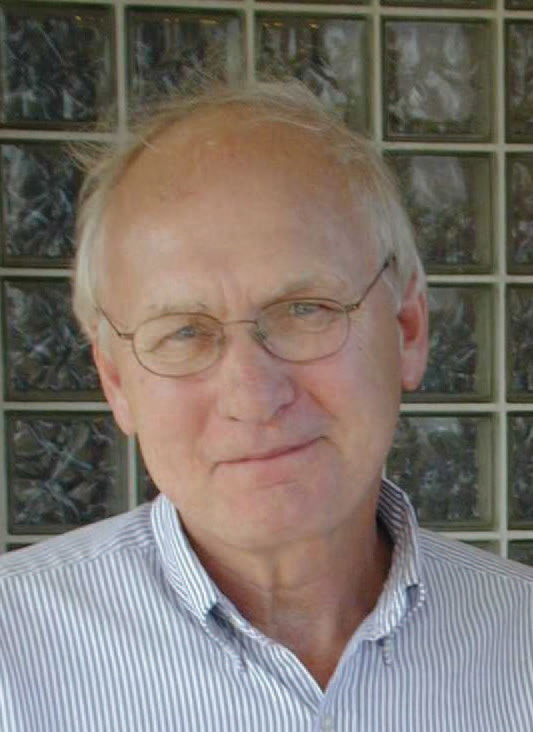
Canada has a long tradition in Mineralogical Crystallography, and several founder members of the Canadian Mineralogist, a major international mineralogical journal, were crystallographers. The number of crystallographers has not been great, but they have been influential in the science of Mineralogy for the second half of the 20th century. Minerals are complicated materials, and work on single-crystal diffraction has gone hand-in-hand with Microbeam Chemical Analysis, Spectroscopy, and work on the theoretical aspects of the solid state. Here, I will focus on the last 20 years with some reference to historical provenance.
Mike Fleet is a geochemist, an import from Manchester (England), who has recently retired from the University of Western Ontario but is still extremely active. Mike has wide interests in Geochemistry and Crystallography, Mike is interested in basic rocks which host platinum-group metals, the distribution of REES (Rare-Earth Elements) in apatite and synthetic analogues, EXAFS and XANES of sulfide minerals, and the structure of glasses. Although much of this work is not directly single-crystal diffraction, Mike does extensive structure work to provide an atomistic perspective to his geochemical interests.
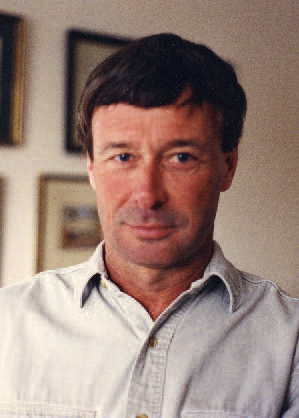 Joel Grice [after whom griceite, LiF, was named] is a Research Scientist with the Canadian Museum of Nature in Ottawa. Joel, a native of Ontario, did his Ph.D. with Bob Ferguson at the University of Manitoba on the structures of the Ta-Nb-oxide minerals. He has broad interests in the description and structural crystallography of new minerals and has made major contributions to our understanding of borate and carbonate minerals, producing structural hierarchies for the latter two groups of minerals that provide the basis for a structural and paragenetic understanding of the behaviour in rocks. Joel was Chair of the International Mineralogical Association's Commission on New Minerals and Mineral Names for eight years, the most high-profile position in Mineralogy, and was among the top ten most highly cited Geoscientists for the decade 1997-2006. Joel Grice [after whom griceite, LiF, was named] is a Research Scientist with the Canadian Museum of Nature in Ottawa. Joel, a native of Ontario, did his Ph.D. with Bob Ferguson at the University of Manitoba on the structures of the Ta-Nb-oxide minerals. He has broad interests in the description and structural crystallography of new minerals and has made major contributions to our understanding of borate and carbonate minerals, producing structural hierarchies for the latter two groups of minerals that provide the basis for a structural and paragenetic understanding of the behaviour in rocks. Joel was Chair of the International Mineralogical Association's Commission on New Minerals and Mineral Names for eight years, the most high-profile position in Mineralogy, and was among the top ten most highly cited Geoscientists for the decade 1997-2006.
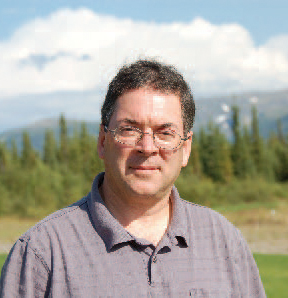 Lee Groat is Professor of Mineralogy at the University of British Columbia. Lee, also originally from Ontario, did his doctoral work with Frank Hawthorne at the University of Manitoba on the crystal chemistry of vesuvianite and has since worked on a variety of minerals. Lee's principal current interest is in the properties and occurrence of gemstones. He has pioneered this topic from a scientific perspective, organizing many Symposia and Short Courses, and has been closely involved with current exploration for gem deposits in Canada. Lee Groat is Professor of Mineralogy at the University of British Columbia. Lee, also originally from Ontario, did his doctoral work with Frank Hawthorne at the University of Manitoba on the crystal chemistry of vesuvianite and has since worked on a variety of minerals. Lee's principal current interest is in the properties and occurrence of gemstones. He has pioneered this topic from a scientific perspective, organizing many Symposia and Short Courses, and has been closely involved with current exploration for gem deposits in Canada.
 Frank Hawthorne [frankhawthorneite, Cu2+Te6+O4(OH)2 ] is Canada Research Chair in Crystallography and Mineralogy at the University of Manitoba. Frank, originally from Bristol (England), did his Ph.D. with Doug Grundy at MacMaster University on the crystal chemistry of the amphiboles. He is interested in the relation between bond topology and energetics in minerals, has developed the idea of structural hierarchies in minerals based on bond topology, and its relation to sequential crystallization of minerals, particularly from aqueous solutions. He has worked extensively on rock-forming minerals (amphiboles, staurolite, tourmalines, micas) using both single-crystal diffraction, microbean analysis (EMPA, SIMS) and a wide variety of spectrocopic methods (infrared, MAS NMR, Mössbauer etc.), and has shown that short-range order is a major feature that controls much of the behaviour of these minerals. Frank Hawthorne [frankhawthorneite, Cu2+Te6+O4(OH)2 ] is Canada Research Chair in Crystallography and Mineralogy at the University of Manitoba. Frank, originally from Bristol (England), did his Ph.D. with Doug Grundy at MacMaster University on the crystal chemistry of the amphiboles. He is interested in the relation between bond topology and energetics in minerals, has developed the idea of structural hierarchies in minerals based on bond topology, and its relation to sequential crystallization of minerals, particularly from aqueous solutions. He has worked extensively on rock-forming minerals (amphiboles, staurolite, tourmalines, micas) using both single-crystal diffraction, microbean analysis (EMPA, SIMS) and a wide variety of spectrocopic methods (infrared, MAS NMR, Mössbauer etc.), and has shown that short-range order is a major feature that controls much of the behaviour of these minerals.
 Grant Henderson is Professor of Mineralogy at the University of Toronto. Grunt evolved and did his undergraduate work in New Zealand and then came to Canada to do his Ph.D. with Mike Fleet at Western. Grant has worked extensively on the surface properties of minerals using Atomic Force Microscopy, and is now involved primarily in the structure of amorphous materials, particularly glasses and liquids. He uses EXAFS, XANES, MAS NMR and Raman spectroscopies to elucidate the structures of germanate, silicate and aluminosilicate glasses to derive information on speciation, coordination and linkage. Grant Henderson is Professor of Mineralogy at the University of Toronto. Grunt evolved and did his undergraduate work in New Zealand and then came to Canada to do his Ph.D. with Mike Fleet at Western. Grant has worked extensively on the surface properties of minerals using Atomic Force Microscopy, and is now involved primarily in the structure of amorphous materials, particularly glasses and liquids. He uses EXAFS, XANES, MAS NMR and Raman spectroscopies to elucidate the structures of germanate, silicate and aluminosilicate glasses to derive information on speciation, coordination and linkage.
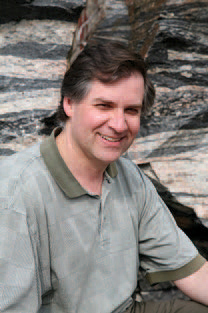 Andy McDonald is Professor of Mineralogy at Laurentian University. He did his Ph.D. with George Chao at Carleton University on minerals of the Mont Saint-Hilaire intrusion in Quebec, and has since worked extensively on the structures of accessory minerals in alkaline rocks, describing several new minerals. More recently, he has been working on the structures of the platinum-group minerals, a broad group of economically important minerals that are the economic source of platinum-group elements, and on the crystal-chemistry of tourmaline-group minerals associated with economic mineral deposits, with a view to developing exploration indicators for platinum-group elements and high field-strength elements (e.g., Ta, Nb). Andy McDonald is Professor of Mineralogy at Laurentian University. He did his Ph.D. with George Chao at Carleton University on minerals of the Mont Saint-Hilaire intrusion in Quebec, and has since worked extensively on the structures of accessory minerals in alkaline rocks, describing several new minerals. More recently, he has been working on the structures of the platinum-group minerals, a broad group of economically important minerals that are the economic source of platinum-group elements, and on the crystal-chemistry of tourmaline-group minerals associated with economic mineral deposits, with a view to developing exploration indicators for platinum-group elements and high field-strength elements (e.g., Ta, Nb).
 Ron Peterson is Professor of Mineralogy at Queen's University. Ron Peterson is Professor of Mineralogy at Queen's University.
He did his B.Sc. at Western, an M.Sc. at McGill and his Ph.D. at Virginia Polytechnic Institute with Jerry Gibbs. Ron is interested in minerals that occur in mine waste, particularly natural and synthetic hydroxy-hydrated transition-metal sulfates. These structures are particularly sensitive to temperature and ambient humidity, and Ron has constructed apparatus to examine their stability and dehydration/hydration processes as a function of these variables.
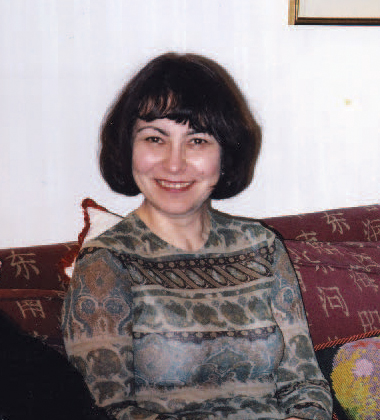 Elena Sokolova [sokolovaite, CsLi2AlSi4O10F2] is Research Professor at the University of Manitoba. Elena was born in Moscow, Russia, and did her Ph.D. with N.V. Belov at Moscow State University on the structures of synthetic borate compounds. Since then, she has worked extensively on a wide variety of minerals. Her primary interest is in the structures of Ti-silicate minerals where she has imposed order on a bewildering variety of very complex structures. She has worked extensively on the structures of new minerals from granitic pegmatites, particularly from Dara-i-Pioz in Tadjikistan, and the peralkaline rocks of the Kola Peninsula. She also heads a major collaborative project with the Institute of the Geology of Ore Deposits: Petrography, Mineralogy and Geochemistry of the Russian Academy of Sciences on the crystal chemistry of minerals from the Kola Superdeep Borehole, the deepest hole (12.2 km) ever drilled in the Earth's crust. Elena Sokolova [sokolovaite, CsLi2AlSi4O10F2] is Research Professor at the University of Manitoba. Elena was born in Moscow, Russia, and did her Ph.D. with N.V. Belov at Moscow State University on the structures of synthetic borate compounds. Since then, she has worked extensively on a wide variety of minerals. Her primary interest is in the structures of Ti-silicate minerals where she has imposed order on a bewildering variety of very complex structures. She has worked extensively on the structures of new minerals from granitic pegmatites, particularly from Dara-i-Pioz in Tadjikistan, and the peralkaline rocks of the Kola Peninsula. She also heads a major collaborative project with the Institute of the Geology of Ore Deposits: Petrography, Mineralogy and Geochemistry of the Russian Academy of Sciences on the crystal chemistry of minerals from the Kola Superdeep Borehole, the deepest hole (12.2 km) ever drilled in the Earth's crust.
|

 Joel Grice [after whom griceite, LiF, was named] is a Research Scientist with the Canadian Museum of Nature in Ottawa. Joel, a native of Ontario, did his Ph.D. with Bob Ferguson at the University of Manitoba on the structures of the Ta-Nb-oxide minerals. He has broad interests in the description and structural crystallography of new minerals and has made major contributions to our understanding of borate and carbonate minerals, producing structural hierarchies for the latter two groups of minerals that provide the basis for a structural and paragenetic understanding of the behaviour in rocks. Joel was Chair of the International Mineralogical Association's Commission on New Minerals and Mineral Names for eight years, the most high-profile position in Mineralogy, and was among the top ten most highly cited Geoscientists for the decade 1997-2006.
Joel Grice [after whom griceite, LiF, was named] is a Research Scientist with the Canadian Museum of Nature in Ottawa. Joel, a native of Ontario, did his Ph.D. with Bob Ferguson at the University of Manitoba on the structures of the Ta-Nb-oxide minerals. He has broad interests in the description and structural crystallography of new minerals and has made major contributions to our understanding of borate and carbonate minerals, producing structural hierarchies for the latter two groups of minerals that provide the basis for a structural and paragenetic understanding of the behaviour in rocks. Joel was Chair of the International Mineralogical Association's Commission on New Minerals and Mineral Names for eight years, the most high-profile position in Mineralogy, and was among the top ten most highly cited Geoscientists for the decade 1997-2006. Lee Groat is Professor of Mineralogy at the University of British Columbia. Lee, also originally from Ontario, did his doctoral work with Frank Hawthorne at the University of Manitoba on the crystal chemistry of vesuvianite and has since worked on a variety of minerals. Lee's principal current interest is in the properties and occurrence of gemstones. He has pioneered this topic from a scientific perspective, organizing many Symposia and Short Courses, and has been closely involved with current exploration for gem deposits in Canada.
Lee Groat is Professor of Mineralogy at the University of British Columbia. Lee, also originally from Ontario, did his doctoral work with Frank Hawthorne at the University of Manitoba on the crystal chemistry of vesuvianite and has since worked on a variety of minerals. Lee's principal current interest is in the properties and occurrence of gemstones. He has pioneered this topic from a scientific perspective, organizing many Symposia and Short Courses, and has been closely involved with current exploration for gem deposits in Canada.

 Frank Hawthorne [frankhawthorneite, Cu
Frank Hawthorne [frankhawthorneite, Cu Grant Henderson is Professor of Mineralogy at the University of Toronto. Grunt evolved and did his undergraduate work in New Zealand and then came to Canada to do his Ph.D. with Mike Fleet at Western. Grant has worked extensively on the surface properties of minerals using Atomic Force Microscopy, and is now involved primarily in the structure of amorphous materials, particularly glasses and liquids. He uses EXAFS, XANES, MAS NMR and Raman spectroscopies to elucidate the structures of germanate, silicate and aluminosilicate glasses to derive information on speciation, coordination and linkage.
Grant Henderson is Professor of Mineralogy at the University of Toronto. Grunt evolved and did his undergraduate work in New Zealand and then came to Canada to do his Ph.D. with Mike Fleet at Western. Grant has worked extensively on the surface properties of minerals using Atomic Force Microscopy, and is now involved primarily in the structure of amorphous materials, particularly glasses and liquids. He uses EXAFS, XANES, MAS NMR and Raman spectroscopies to elucidate the structures of germanate, silicate and aluminosilicate glasses to derive information on speciation, coordination and linkage.  Andy McDonald is Professor of Mineralogy at Laurentian University. He did his Ph.D. with George Chao at Carleton University on minerals of the Mont Saint-Hilaire intrusion in Quebec, and has since worked extensively on the structures of accessory minerals in alkaline rocks, describing several new minerals. More recently, he has been working on the structures of the platinum-group minerals, a broad group of economically important minerals that are the economic source of platinum-group elements, and on the crystal-chemistry of tourmaline-group minerals associated with economic mineral deposits, with a view to developing exploration indicators for platinum-group elements and high field-strength elements (e.g., Ta, Nb).
Andy McDonald is Professor of Mineralogy at Laurentian University. He did his Ph.D. with George Chao at Carleton University on minerals of the Mont Saint-Hilaire intrusion in Quebec, and has since worked extensively on the structures of accessory minerals in alkaline rocks, describing several new minerals. More recently, he has been working on the structures of the platinum-group minerals, a broad group of economically important minerals that are the economic source of platinum-group elements, and on the crystal-chemistry of tourmaline-group minerals associated with economic mineral deposits, with a view to developing exploration indicators for platinum-group elements and high field-strength elements (e.g., Ta, Nb).  Ron Peterson is Professor of Mineralogy at Queen's University.
Ron Peterson is Professor of Mineralogy at Queen's University.  Elena Sokolova [sokolovaite, CsLi
Elena Sokolova [sokolovaite, CsLi